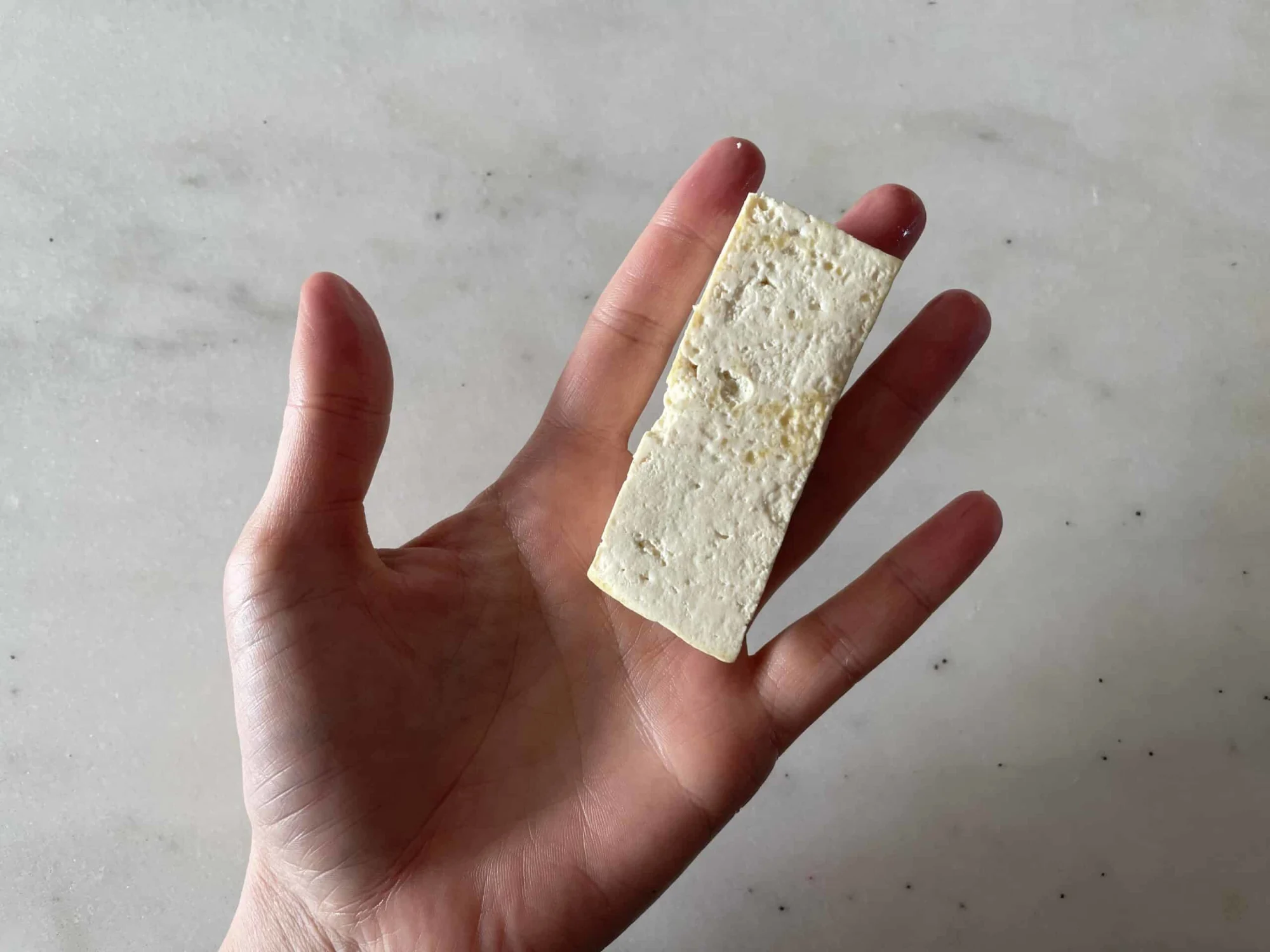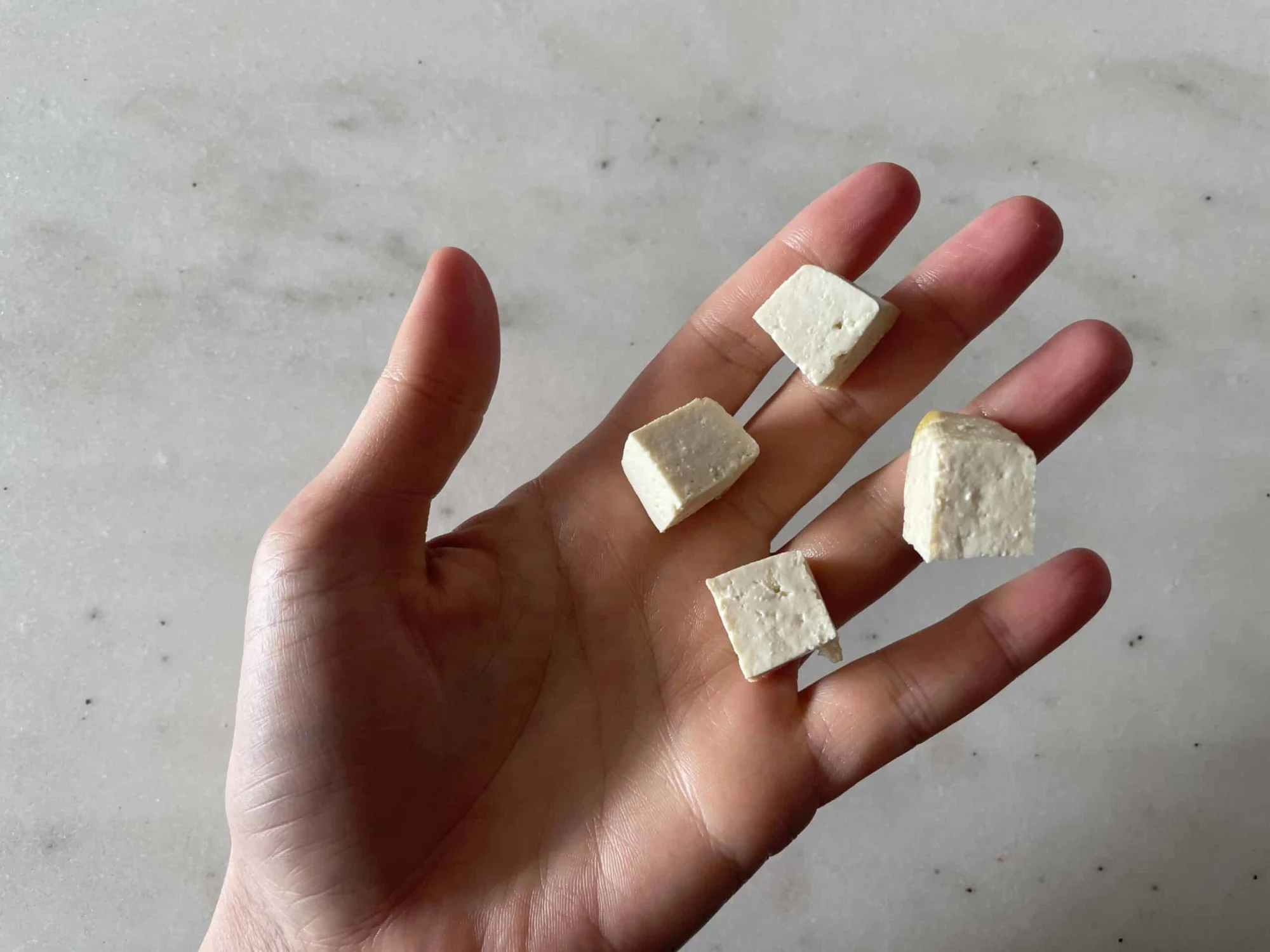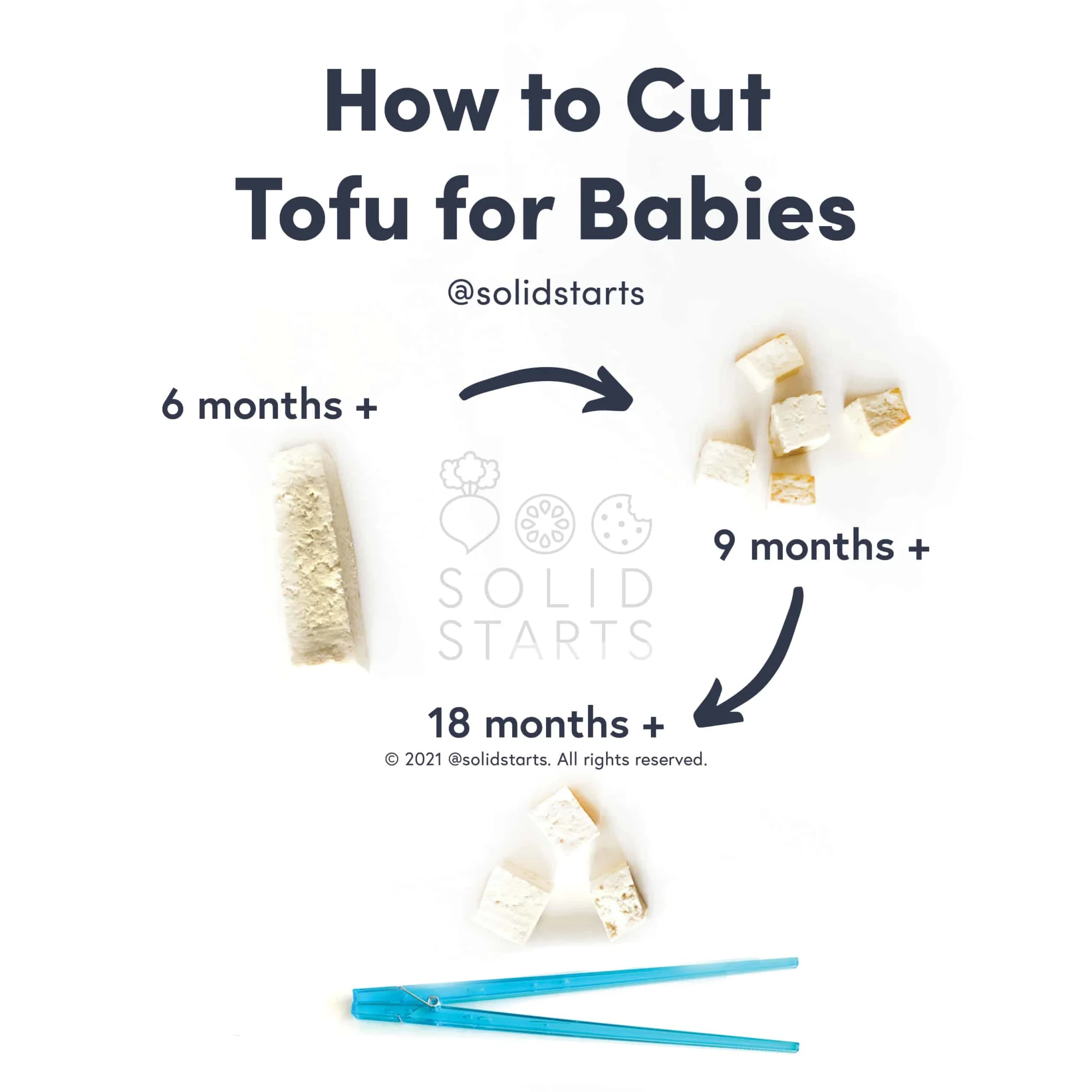Access our First Foods® Database in the Solid Starts App.
Learn moreTofu
Legume
Age Suggestion
6 months
Iron-Rich
Yes
Common Allergen
Yes

When can babies have tofu?
Tofu may be introduced as soon as baby is ready to start solids, which is generally around 6 months of age. Take care when introducing tofu, as it contains soy and sometimes other common food allergens.
Thousands of years ago in Central Asia, humans learned how to turn soybeans into tofu. The process of making tofu is very similar to cheese-making techniques, but instead of cow’s milk, tofu is made with soy milk from cooked soybeans, a sacred staple in Central Asian cultures.
How do you serve tofu to babies?
Every baby develops on their own timeline, and the suggestions on how to cut or prepare particular foods are generalizations for a broad audience.
6 months old +:
Silken tofu offers a smooth texture that can be eaten on its own or stirred into soft, scoopable foods. You can also offer long, thick strips of firm or extra-firm tofu for baby to suck and munch on. If a piece breaks off in baby’s mouth, take a deep breath, stay calm, and allow baby to start to chew the tofu, or move it forward and spit it out. You can also coach them to spit it out by sticking out your tongue. Refrain from offering stinky tofu and other fermented tofu in brines or marinades until a child is older.
9 months old +:
At this age, babies may start to get ambitious and shovel food into the mouth. It’s also the age when babies develop the pincer grasp (where the thumb and pointer finger meet), which enables them to pick up smaller pieces of food. When you see these signs, try moving down in size to smaller, bite-sized cubes of firm or extra-firm tofu alongside some larger strips for biting practice. At this age, silken tofu is also great as it can help with utensil practice. Try preloading a spoon and passing the spoon in the air for baby to grab.
12 months old +:
Offer bite-sized cubes of firm or extra-firm tofu and consider introducing trainer chopsticks or a fork to encourage utensil practice. You can also preload a spoon of silken tofu and rest it next to the food for the child to try to pick up. If the child rejects the utensil, don’t worry: learning to use utensils is exhausting for young eaters and many children toggle between eating with hands and utensils. Be patient: consistent, independent utensil use may not come until after 2 years of age.


Learn which nutrients are most important for vegetarian and vegan babies in our guide, Best & Worst Plant-Based Foods for Babies.
Videos
Is tofu a choking hazard for babies?
No. Tofu presents a low risk when safely prepared for a child’s age and developmental ability, though, in theory, an individual could choke on any food. To reduce the risk, prepare and serve tofu in an age-appropriate way as described in the How to Serve section. As always, make sure you create a safe eating environment and stay within an arm’s reach of baby during meals.
Learn the signs of choking and gagging and more about choking first aid in our free guides, Infant Rescue and Toddler Rescue.
Is tofu a common allergen?
Yes. Tofu is made of soybeans, a common food allergen among infants, and some ready-to-eat brands include other common allergens like sesame and wheat.
However, there is good news: less than 1% of children are allergic to soy, reactions tend to be mild (although severe reactions to soy have been reported), and almost 70% of children outgrow their allergy by age 10. For these reasons, soy is not classified as a Global Priority Allergen by the World Health Organization.
If baby is allergic to soy, avoid soybeans and any products containing soy, such as tofu, tempeh, edamame, miso, natto, soy sauce, tamari, and prepared food that lists soy as an ingredient on the food label. In the United States, soy is designated as a common food allergen and therefore, it will be declared on a food label if soy is present in the ingredients. When shopping, avoid products that contain the phrase “contains soy” on the food label.
Most individuals with soy allergy can tolerate highly refined soy oil and soy lecithin (a common ingredient added to foods) because they contain very little allergenic protein. However, be sure to check with your healthcare provider before offering food with soy oil or soy lecithin to a child with soy allergy.
Although a significant percentage of children with soy allergy may also be sensitized to peanut (and vice versa) on testing, this does not always translate into a clinical allergy. If baby has experienced an allergic reaction to soy, and you have not yet introduced peanut, you may wish to introduce peanut under the supervision of an allergist. However, there is no need to remove peanut from the diet or pursue peanut testing if it is already being eaten without any reaction. Likewise, babies with peanut allergy do not need to eliminate soy if it is already well-tolerated in the diet.
Some babies with cow’s milk allergy are sensitive to soy. In fact, 10 to 14% of patients with cow’s milk allergy also present with allergic reactions to soy. This is more likely to be seen in babies under 6 months of age. For this reason, many pediatricians recommend that babies with a known milk allergy preemptively avoid both cow’s milk and soy for the first 6 months of life, and they may recommend extensively hydrolyzed or elemental infant formula instead of soy formula during this time.
Individuals with Oral Allergy Syndrome (also known as food-pollen allergy syndrome), especially those allergic to birch pollen, may experience symptoms after the ingestion of soy. Oral Allergy Syndrome typically presents with short-lived itching, tingling, or burning in the mouth, and is unlikely to result in a severe reaction. That said, serious reactions to soy in individuals with birch pollen allergy have been reported, most commonly in individuals who are also allergic to peanut.
Soy is a known cause of food protein-induced enterocolitis syndrome, also known as FPIES. FPIES is a delayed allergy to food protein which causes the sudden onset of repetitive vomiting and diarrhea to begin a few hours after ingestion. This is termed acute FPIES. Left untreated, the reaction can result in significant dehydration. When soy is in the diet regularly, FPIES can present as reflux, weight loss, and failure to thrive. This is termed chronic FPIES. Symptoms generally improve with elimination of soy from the baby’s diet. Thankfully, like other forms of soy allergy, FPIES that presents early in life is generally outgrown by the time the child has reached 3 to 5 years of age.
Soybeans and soy-containing products are commonly prepared with other common allergens, such as egg, fish, peanut, and sesame. It is important to introduce common food allergens on their own and rule out an allergy before serving them together.
When introducing tofu to baby, start with a type and preparation that contains no other common food allergens. As with all common allergens, start by serving a small quantity on its own for the first few servings, and if there is no adverse reaction, gradually increase the quantity over future meals. Once common food allergens are successfully introduced, it is recommended to keep them in the diet regularly (twice weekly, if possible).
Is tofu healthy for babies?
Yes. Tofu is rich in protein, plant-based omega-3 fatty acids, iron, and zinc. Together, these nutrients support growth and development, brain health, healthy red blood cells, and strong immunity and taste perception. Some forms of tofu are also rich in calcium to help support baby’s developing bones. To help boost iron absorption from tofu, pair tofu with vitamin C-rich foods, like bell pepper, broccoli, and citrus. If you are looking to add calcium in a child’s diet, read the label and choose brands that include calcium sulfate on the ingredient list. Brands prepared with calcium sulfate, a natural coagulant that helps turn soy milk into tofu, are higher in calcium than brands that use other types of coagulants.
What kind of tofu is best for babies?
All tofu contains essential nutrients to nourish a growing child, although some offer more nutrition. For example, silken tofu often contains less protein and micronutrients than firm and extra-firm tofu, which are loaded with protein, iron, and zinc. Sprouted tofu tends to have more protein and less fat than non-sprouted types.
Food texture is an integral part of developing a baby’s eating habits, and different types of tofu offer different experiences. Silken tofu is so soft that it can easily be mixed into scoopable foods or used as a substitute for dairy products like cream or yogurt. Firm and extra-firm tofu can be a great finger food and seasoned with spices to introduce new flavors.
Can babies eat raw tofu?
Yes. Store-bought tofu can be eaten straight from the container, since it has typically already been pasteurized to kill any potentially harmful bacteria and is no longer technically “raw.”
Do I need to worry about the phytoestrogens in tofu?
No. Tofu, soy products, and a wide variety of other foods contain phytoestrogens, which are plant compounds that can behave similarly as estrogen in the human body. Estrogen is present in humans of all genders and is not only limited to females. There is no evidence to suggest limiting phytoestrogen intake in babies and toddlers, and some studies suggest that consuming foods that contain phytoestrogens can offer beneficial properties, such as decreasing the risk of breast cancer and promoting bone health. That said, there is no perfect food, and consuming a balanced diet with a wide variety of whole foods is key to one’s health.
Our Team
Written by
Expert Tips Delivered to Your Inbox
Sign up for weekly tips, recipes and more!
Copyright © 2025 • Solid Starts Inc






